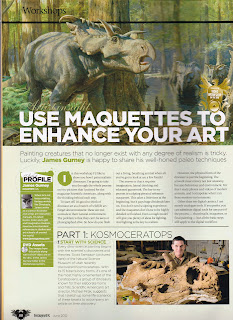My traditional art skills using pen, pencil and paper has have improved further using light and dark pencil on brown paper enabling me to create rendering techniques, this i also carried through into my digital art, using new grey scale and texturing techniques which enabled me to achieve new levels of realism i hadn't discovered before. I believe the use of textures i made myself using Maya software dramatically changed the look of my final concepts as well as saving me time i would have spent individually painting each hair as i have been known to do in the past. As a result of the discovery of these techniques i am very happy and comfortable using them within my future artworks.
I have also learnt to identify flaws in other creature designs and how i would personally alter that design to achieve a greater realism with consideration to natural history. I realise how important it is to look to creatures in existence in the world today for inspirations as it is surprising what can be achieved in a creature design when combining and using aspects of nature.
I feel this Semester has taught me so much and i have improved greatly as a Creature Designer from this Semester alone, and my discoveries and achievements will continue to flourish in my future works which i believe is a very exciting concept!
So as this exciting Semester 2 draws to a close, below is a list of potential plans and ideas for the 3rd and final Semester starting in September 2012, but between now and then i will be updating this blog with any thoughts, inspirations and works i arrive at over the summer... 'break'.
- To produce a Creature filled book, either in the style of a Field guide and discovery of a new found island, or in the style of a 'Art of' book.
- To experiment with a new found technique i read about in Junes issue of ImagineFX, where artist James Gurney uses Maquettes (Wire frame and Sculpey models) to help understand rendering techniques. (see below images).
- To come up with an effective method of displaying my Natural History knowledge in my show, possibly using either; a life sized model of a creature design using Wire Frame and Sculpey and/or a technique of showing off skeletal, musculature and skin with inspirations from both Terryl Whitlatch and ROA (see INSPIRATION section of this Blog).
- Possible use of Maya to model one of my creatures (or ask a 'Maya whizz' to do this for me) and i will texture and attempt to animate... This is a huge challenge for myself but one i have always aspired to do for as long as i care to remember!
So... busy times ahead to say the least! Summer? What Summer? I'll be doing what i do best...
Designing Creatures! ;)
Above: Two of Six pages from the ImagineFX June 2012 Magazine (see all in Inspiration Section of this blog).
Above: Rough idea for 'Art of' Style book. Left shows brief progression, Right shows Final Design.




